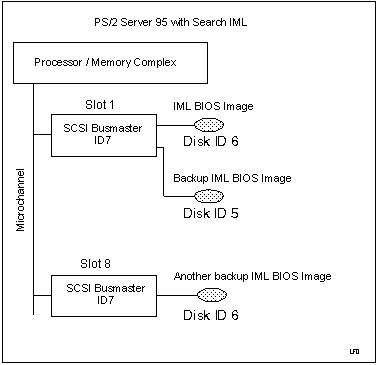|
Original IML BIOS
Search IML
Search IML and Twin Tailing
Search IML Example
Search IML BIOS Search Order
Install System Programs on Search IML System
Original IML BIOS
IML BIOS, which was introduced with the PS/2 Models 90
and 95, provides a method of updating BIOS without requiring a chip replacement.
This provides the benefit of getting the latest BIOS without the hassles
of de-assembling hardware. Processor types 1, 2 and 3 store much of the
microcode (the IML BIOS) in a special partition on the fixed disk of the
PS/2. Upon IPL of the system, the (smaller) ROM BIOS is loaded, and
then the (larger) IML BIOS is read from the disk. The IML BIOS can be upgraded
by doing IPL of the PS/2 from the reference diskette and copying across
the new IML BIOS to the reference partition on the disk. Original processor
types 1 and 2 read the IML BIOS from the disk at SCSI ID 6 on the adapter
in the Micro Channel with the lowest number.
The drawback of this approach is that if the disk on SCSI ID 6 is corrupted,
the PS/2 Model 95 or 90 will no longer boot, since it cannot read in the
IML BIOS.
Search IML (Enhanced BIOS)
Search IML which is implemented in the Type 3 and 4 complexes and available
as an upgrade for Types 1 and 2 complexes solves this problem. It enables the
IML BIOS to be held on more than one disk in the PS/2, and providing a search
routine at IPL that searches all the disks attached to the PS/2 for a valid IML
BIOS and then loads it. This improves the availability of the PS/2, since it
can IPL from another disk in the system even if the main disk has failed.
Search IML and Twin Tailing
The Search IML BIOS can be located in a reference partition on any SCSI disk
attached to a PS/2 that supports Search IML. This includes disks housed in
external enclosures, such as the 3511 and 3510. Find out a little more about
Twin Tailing and Search
IML.
Search IML - Example Configuration

Search IML Search Order
When you IPL a configured system, the Search IML searches all drives on all
adapters in the system for an IML image for the processor complex installed.
The search order is from SCSI ID 6 to 1, and from the adapter in the lowest
slot to the adapter in the highest slot in the Micro Channel. If it finds more
than one IML BIOS image for the installed processor complex, then it will use
the one with the latest date. If there is a configuration error, only the
drives on the first adapter will be searched.
Installing IML BIOS on Search IML System
When a new IML BIOS image is being installed from a reference diskette, it
will overwrite the first image for the installed processor complex. If no image
exists, it will write the image to the disk with the highest SCSI ID attached
to the first adapter card. In order to write IML BIOS images on a new system
(to disks other than SCSI ID 6), it is necessary to temporarily remove the disk
with the system partition. The system partition on the disk (in which the IML
BIOS image is stored) is protected on every disk.
There are four possible IML BIOS images, for Type 1, Type 2, Type 3 and
Flash Type 4 processor cards. The type of IML BIOS image associated with a
processor complex is indicated on the label of the reference diskette packaged
with the system. Type 4 processors go a step further by storing BIOS in Flash
memory. This allows software upgrades, faster POST and is not dependent on a
SCSI adapter.
|